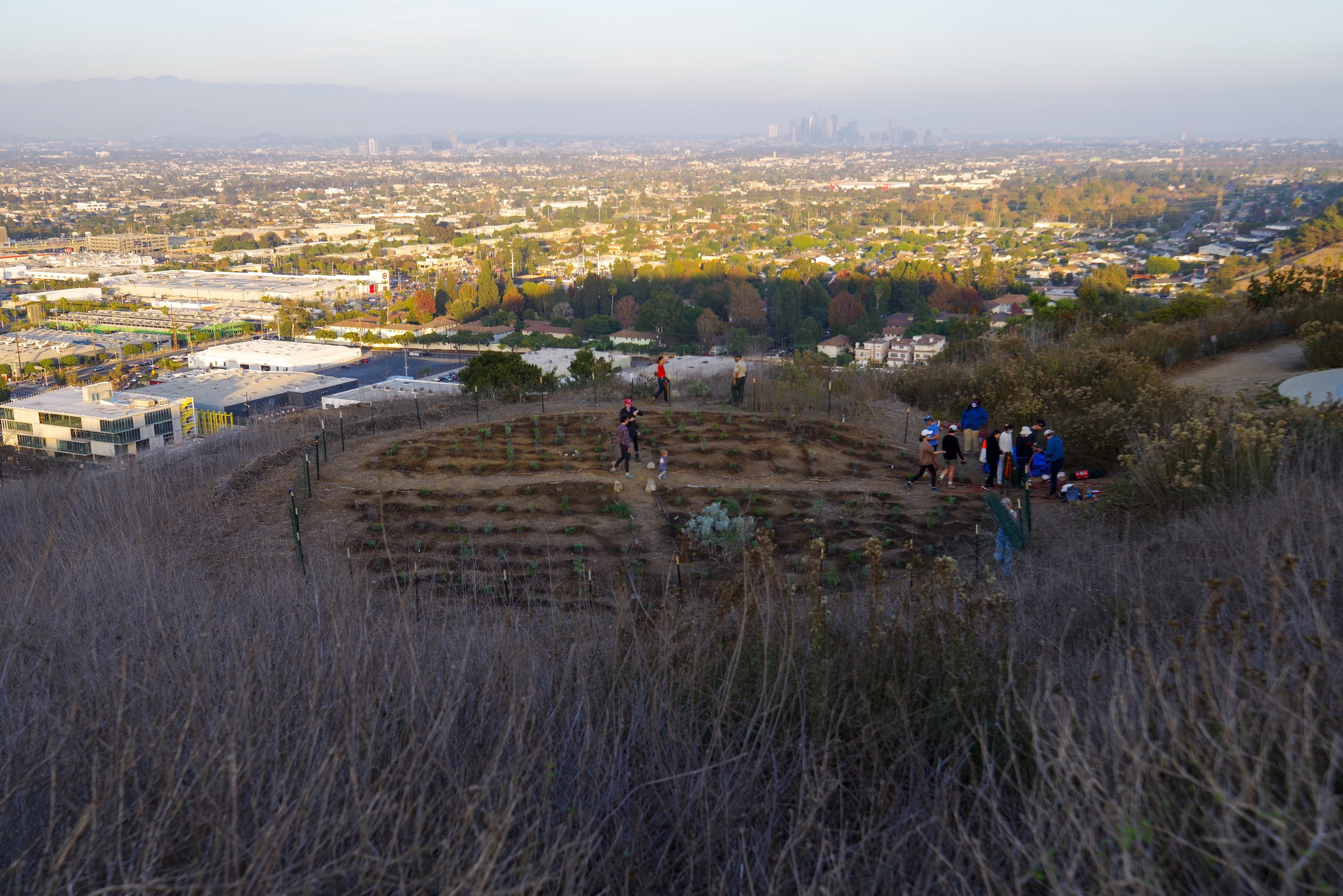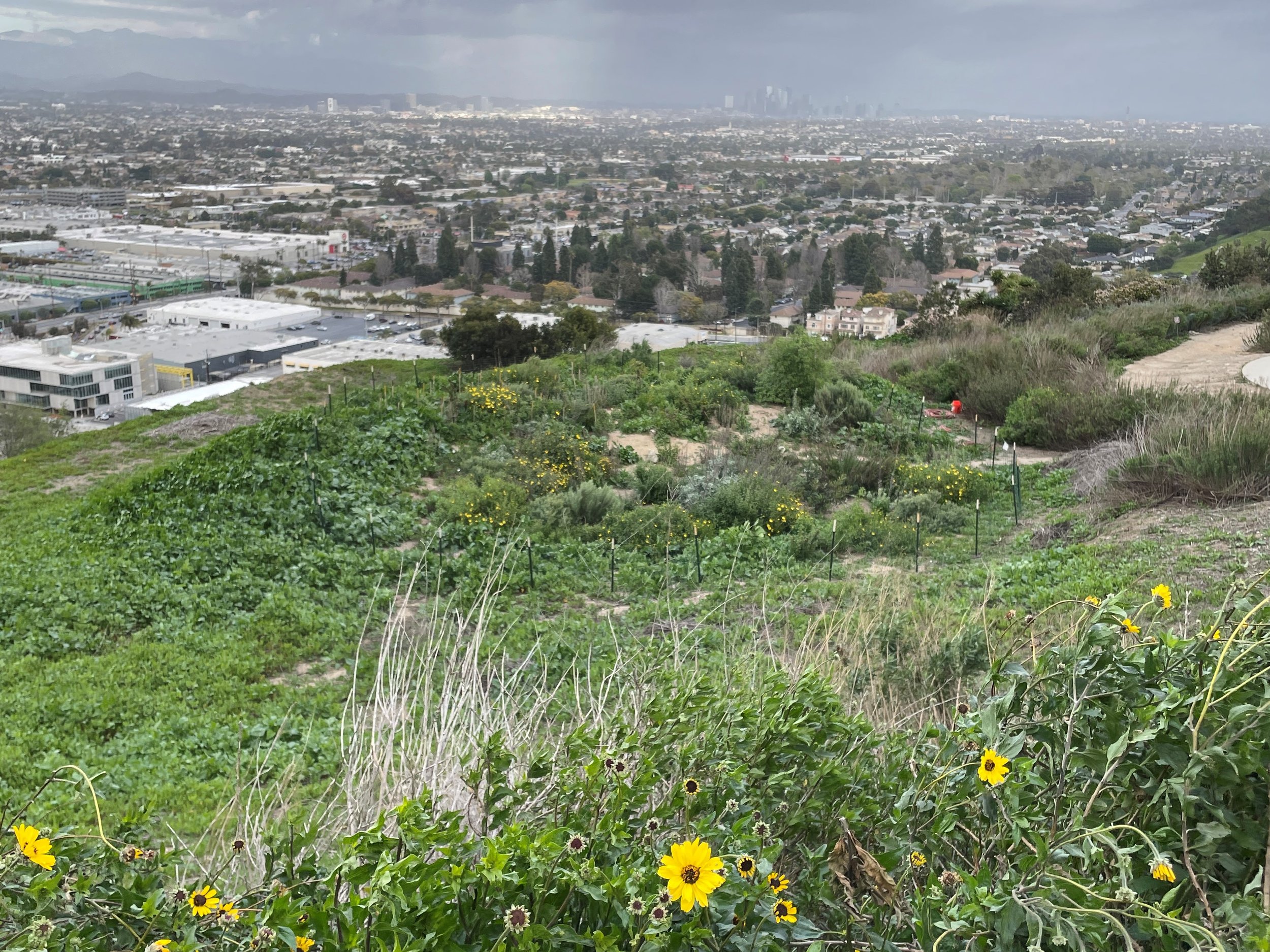Baldwin Hills Test Plot
A testing ground for climate resilience with skyline views of LA
The Baldwin Hills in southwest LA are a series of dome-shaped hills formed by movement on the Newport-Inglewood fault. Millions of years of geological activity led to the collection of natural gas beneath the surface of the present-day Inglewood Oil Fields, a 1,000-acre landscape of black, bobbing derricks. Located just north of the oil fields – in stark contrast – is a 58-acre jewel of restored native habitat called the Baldwin Hills Scenic Overlook (BHSO), also commonly known as the Culver City Stairs for the iconic outdoor staircase that leads you 375 feet above sea level. Even if you’ve never made the trek, perhaps you’ve driven by on the 10 freeway and seen the line of hikers marching up the hill in one straight line. This overlook is just one component of the Baldwin Hills Parklands, the largest urban green space serving the surrounding area of South LA. The 480 acres of public parks are collaboratively managed by California State Parks, LA County Parks and Recreation, LA City Parks and Recreation, Culver City Parks, and Mountains Recreation and Conservation Authority, with help from the nonprofit Nature Nexus Institute. And it keeps growing through new acquisitions, under the supervision of the Baldwin Hills Conservancy.
Planting Day (Nov 2021)
THE TEST
The Test Plot is a roughly 5,000-square foot area near the top of the overlook by the Skyline Terrace Amphitheater. Initially, a field of invasive mustard, a tobacco tree, and a sprinkling of bladderpod, white and black sages filled the site. The fabulous staff from the Nature Nexus Institute began site prep in August 2021 by hand pulling the mustard from the area so we could begin a grow / kill cycle to prepare for planting. After months of watering, site observation, and research on local systems, we developed a planting strategy to test for climate resilience.
Here, one of the big questions is what plant species will thrive in more extreme weather conditions? We chose plants from three different plant communities based on these factors: the historic ecology of the site (southern oak woodland found on the north facing slopes), species from the coastal sage scrub community already present here, and newly introduced grassland species that we know thrive off of increased disturbance. Past, present, future. Choosing this diverse plant palette from the outset was a strategy to allow the land to respond, so to speak. All three plant communities were tested evenly across the site topography to see what thrives and help select the future makeup. An uncertain future climate will strain current plant communities in unknown ways. This skyline plot is a testing ground to find some answers.
BACKGROUND
Over the course of the region’s development, the role of the Baldwin Hills mountain range has shifted from foraging ground for the native Tongva people, to grazing area for the neighboring ranchos, then oil fields, infrastructure and homes. In 1951, the sprawling Baldwin Hills Reservoir came on line and accelerated residential development in enclaves like View Park-Windsor Hills, Baldwin Hills Estates and Baldwin Village. On the whole, Baldwin Hills became one of the first racially integrated neighborhoods in the area. In 1963, a dam failure brought a deluge of water down the hills, knocking out homes and flooding neighborhoods. Today, the bowl of that reservoir is a grassy basin for walking and frisbee golf in Kenneth Hahn Park.
The parklands consist of a patchwork of intact native coastal scrub, pioneer and disturbance-adapted species, as well as introduced nonnatives that are being managed to different degrees. Loved (and sometimes over-loved) by the community, BHSO offers unparalleled views of the LA Basin. It’s a unique vista where you can trace the entire Ballona Creek watershed from the Santa Monica Mountains down to the Pacific Ocean. It’s the place to walk, run and get your steps in. Folks are often out and about listening to slow jams and doing their reps amid the buckwheat, sages and bush sunflower. We recommend ascending at sunrise or sunset. It will take your breath away, twice.
PLANT LIST BY COMMUNITY
OAK WOODLAND
Quercus agrifolia
Juglans californica
Artemisia douglasiana
Heteromeles arbutifolia
Keckiella cordifolia
Lonicera subspicata
Ribes aureum ssp. gracillimum
Ribes speciosum
Rosa californica
Salvia spathacea
Sambucus nigra ssp. caerulea
Coast live oak
California Walnut
Mugwort
Toyon
Climbing penstemon
Southern Honeysuckle
Golden Currant
Fuchsiaflower gooseberry
California wildrose
Hummingbird sage
Blue elderberry
COASTAL SAGE SCRUB
Acmispon glaber (seed)
Artemisia californica
Calystegia macrostegia
Epilobium canum
Encelia californica
Eriogonum fasciculatum
Peritoma arborea
Salvia apiana
Salvia mellifera
Deerweed
California sagebrush
Island morning glory
California fuchsia
Bush sunflower
California buckwheat
Bladderpod
White sage
Black sage
GRASSLAND (seed)
Achillea millefolium
Asclepias fascicularis
Bloomeria crocea
Clarkia unguiculata
Corethrogyne filaginifolia
Deinandra fasciculata
Dichelostemma capitatum
Eriophyllum confertiflorum
Eschscholzia californica
Gilia capitata
Helianthus annuus
Lasthenia californica
Lupinus succulentus
Nemophila menziesii
Solidago velutina
Stipa cernua
Stipa pulchra
Common yarrow
Narrowleaf Milkweed
Goldenstar
Elegant clarkia
California aster
Clustered tarweed
Blue dicks
Golden yarrow
California poppy
Globe gilia
Sunflower
Goldfields
Arroyo lupine
Baby blue eyes
Goldenrod
Nodding needlegrass
Purple needlegrass
LOG
TEAM
—Jen Toy, Lecturer, USC Department of Landscape Architecture + Urbanism
—Arch 642 Test Plot Class Fall 2021
Students: Andrea Binz, Gabrielle Castriotta, Yue Chen, Asher Guzik, Kunyang Guo, Yuxin Jia, Lara Lebeiko, Jin Ma, Dani Velazco, Yifan Yin.
PARTNERS
—LA Audubon + Nature Nexus Institute
Ingrid Carillo, Emily Cobar, Margot Griswold, Arely Mendia Perez, Stacy Vigallon, Brian Young
YEAR
—Nov 2021 initial planting & seeding
—2023-2024 Winter urban superbloom (no germination)
MONITORING
—2021-2022: Hannah Flynn
—2022-2023: Nina Weithorn, Danielle Velazco
—2023-2024: Jeremy Joo
THANK YOU
—The high school students from Baldwin Hills Greenhouse program
—Tree of Life Nursery
—Theodore Payne Nursery
—California State Park
—Evan George (website description)





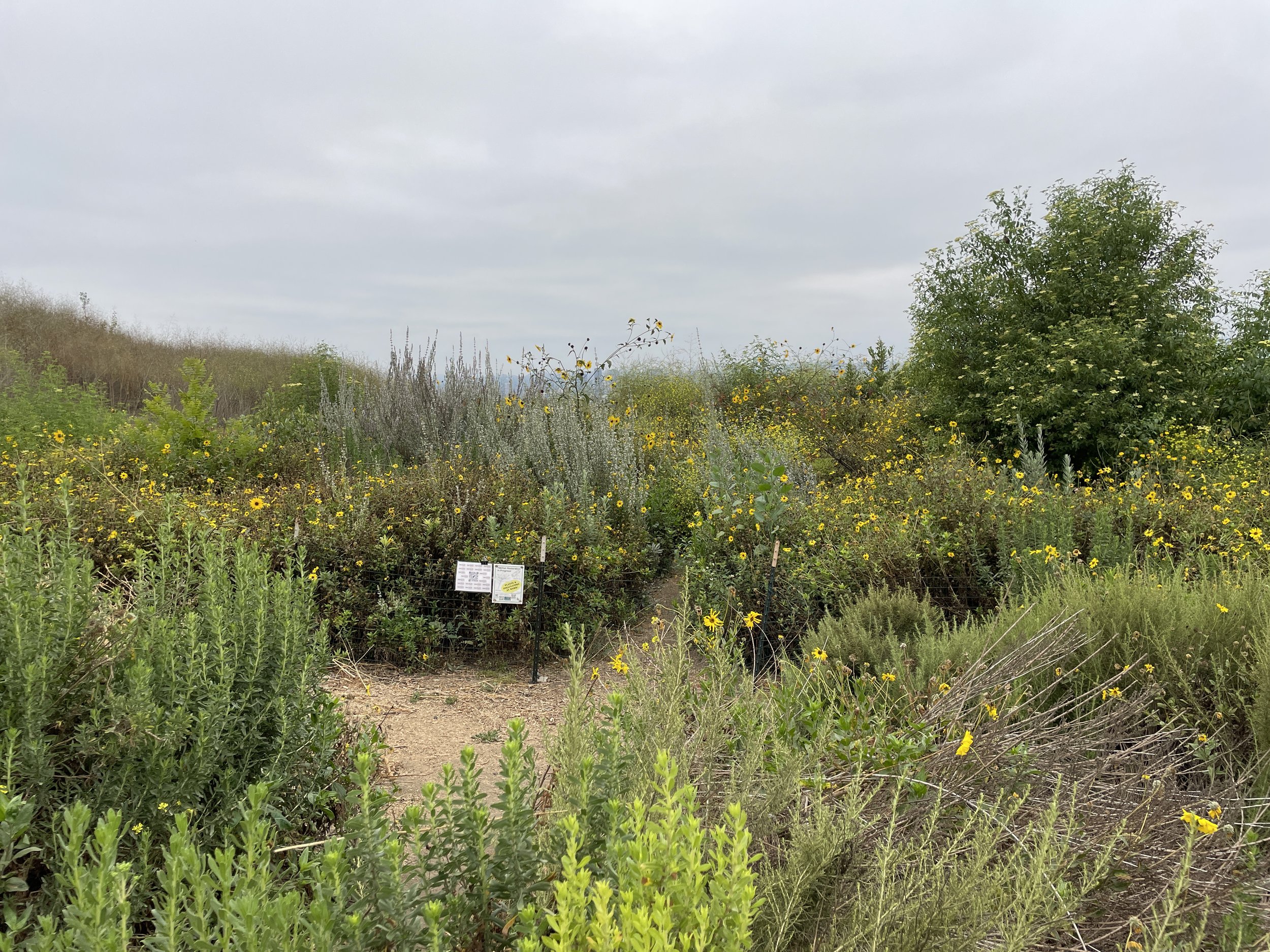
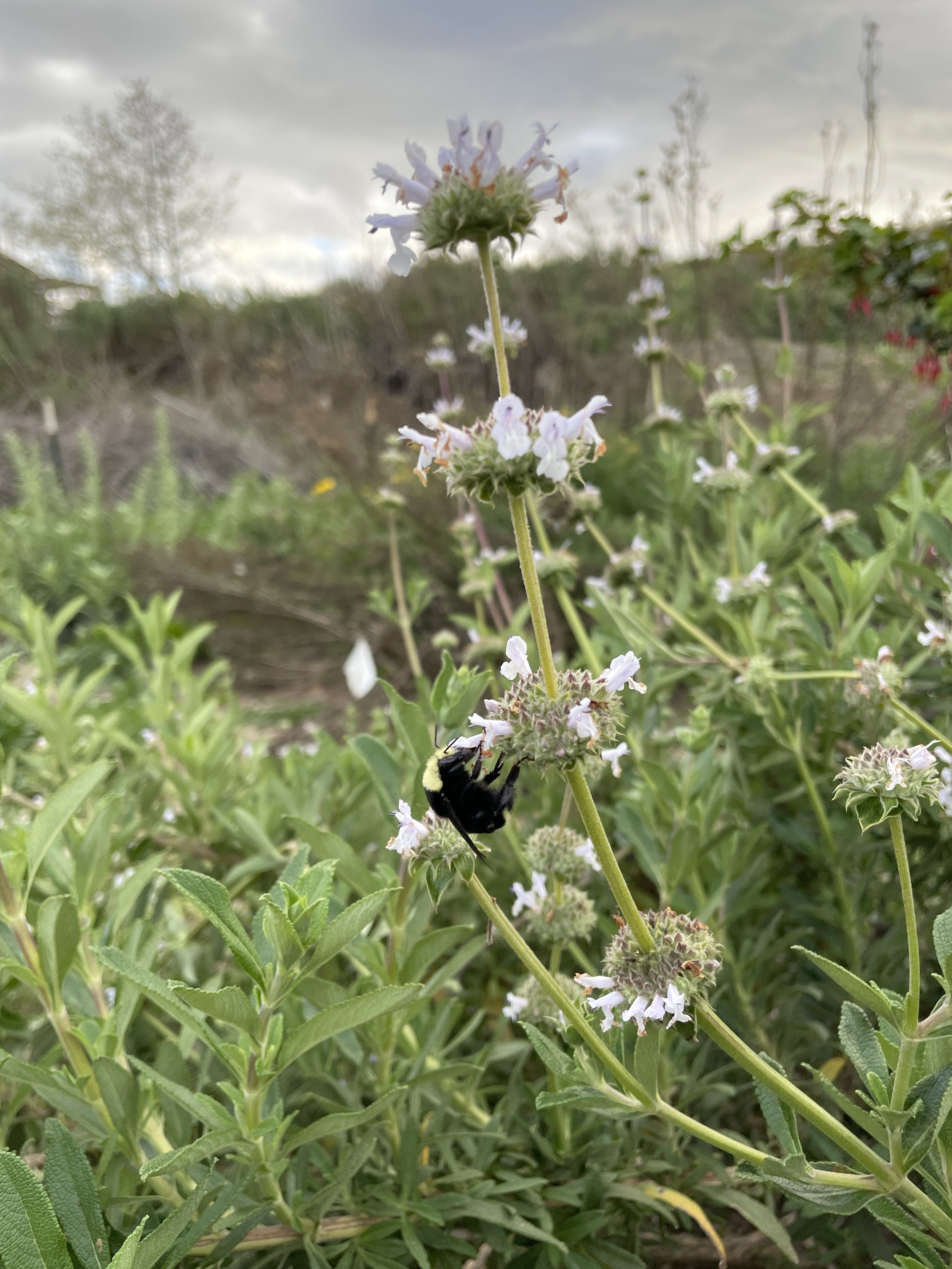


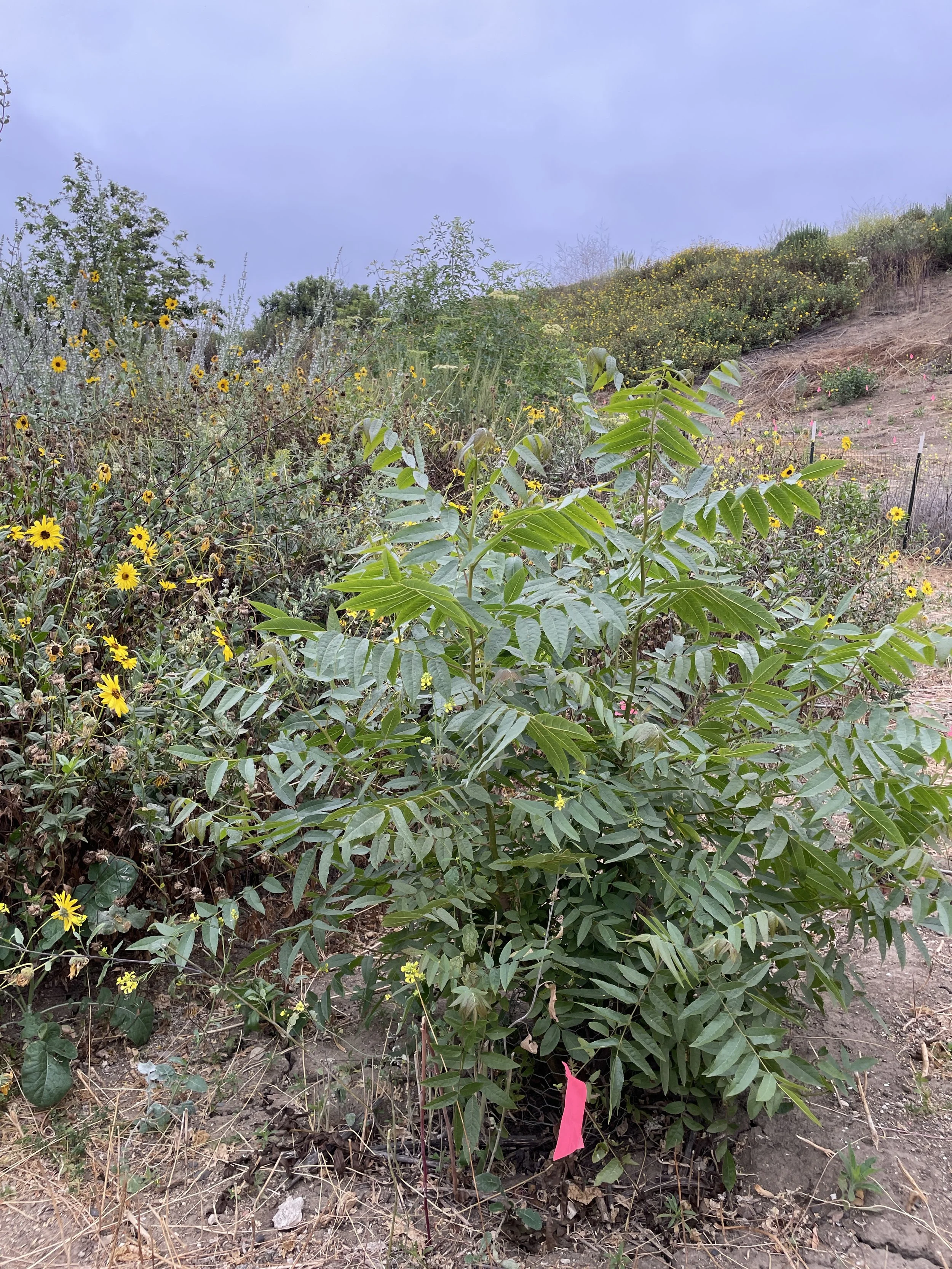


Existing Conditions (August 2021)

Site Clearing (September 2021)

